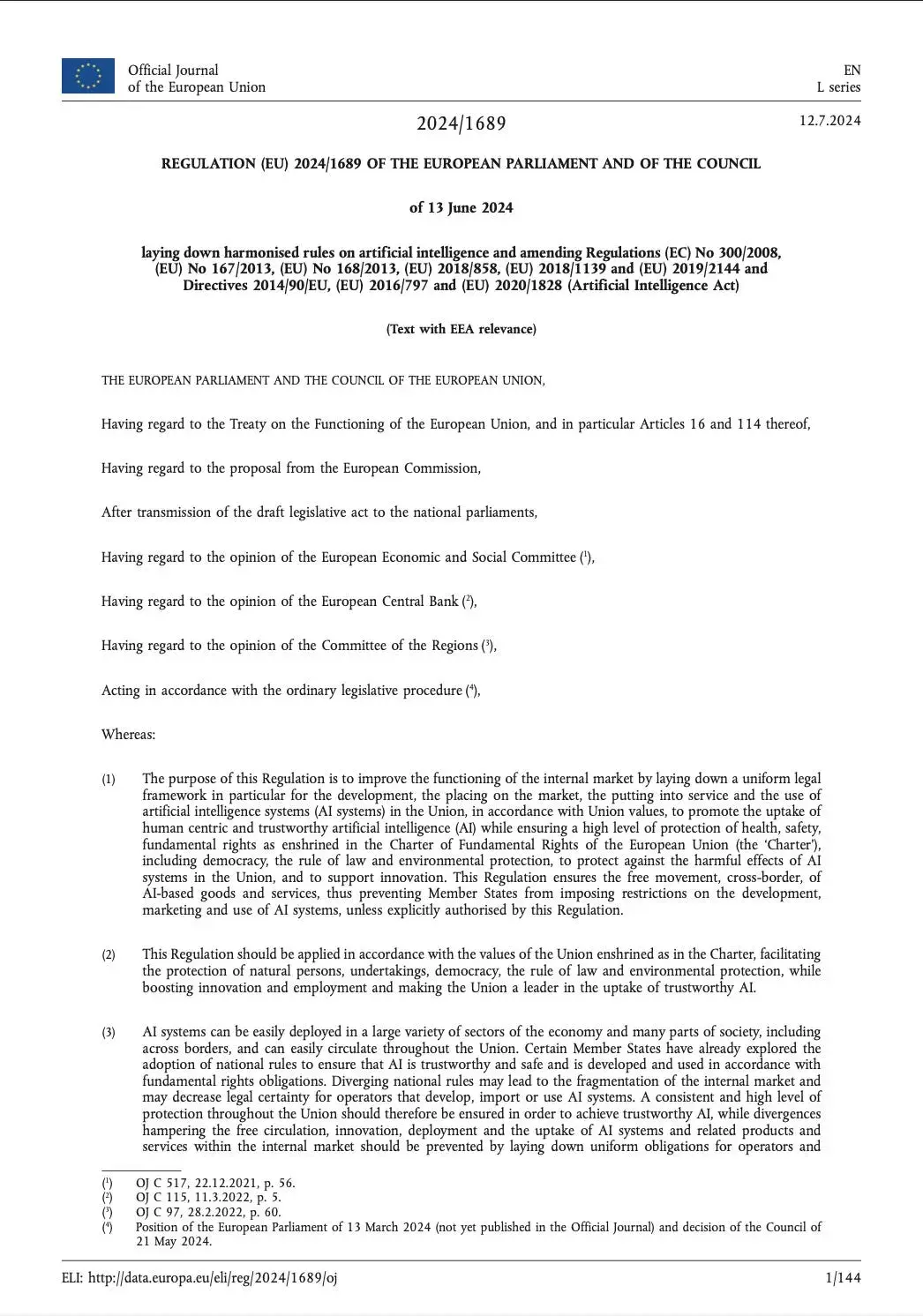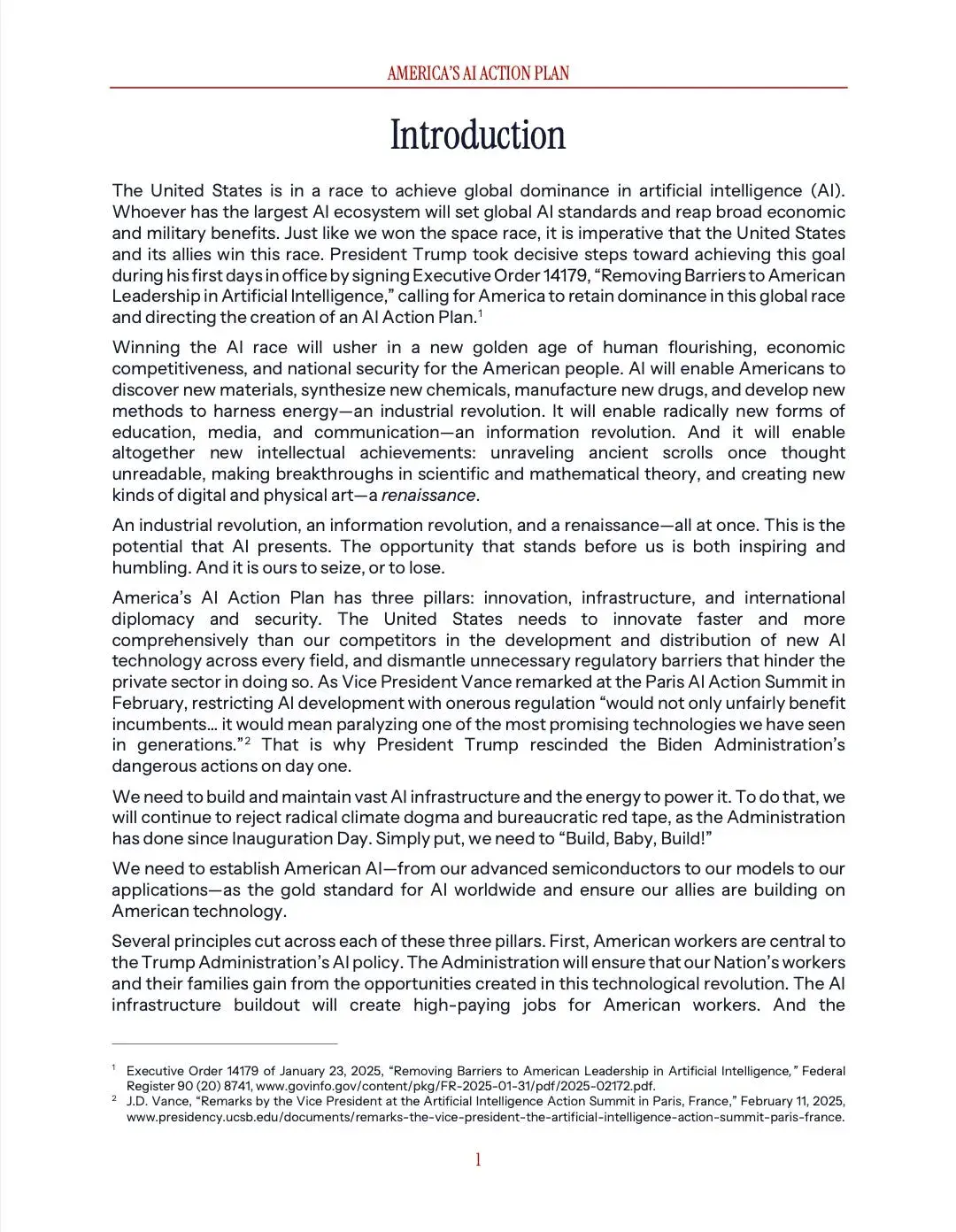I've spent the last decade working across the AI landscape, first at AWS, then at Hugging Face, and now at Arcee AI. During this journey, I've traveled the world and witnessed very different philosophies about AI development, especially across the opposite sides of the Atlantic.
The recently published US AI Action Plan has materialized my observations. What I'm seeing today isn't just a policy disagreement: it's the emergence of two fundamentally different visions. And one of them is going to fail hard.
A Tale of Two Regulations (Or Lack Thereof)
The contrast between European and American approaches to AI governance couldn't be stronger. The EU AI Act represents something unprecedented: a comprehensive attempt to regulate a bleeding-edge technology before it becomes fully established. This regulation's risk-based approach categorizes AI systems from minimal risk to outright prohibition, creating a framework that's thorough, principled, and comprehensive.
🇪🇺 "The purpose of this Regulation is to improve the functioning of the internal market by laying down a uniform legal framework in particular for the development, the placing on the market, the putting into service and the use of artificial intelligence systems (AI systems) in the Union, in accordance with Union values, to promote the uptake of human centric and trustworthy artificial intelligence (AI) while ensuring a high level of protection of health, safety, fundamental rights as enshrined in the Charter of Fundamental Rights of the European Union (the 'Charter'), including democracy, the rule of law and environmental protection, to protect against the harmful effects of AI systems in the Union, and to support innovation. This Regulation ensures the free movement, cross-border, of AI-based goods and services, thus preventing Member States from imposing restrictions on the development, marketing and use of AI systems, unless explicitly authorised by this Regulation."

Meanwhile, the Trump Administration's AI Action Plan reads like a manifesto for the opposite approach. Having rescinded Biden's AI Executive Order on day one, the message is crystal clear: regulation is the enemy of innovation. The plan explicitly calls for removing "onerous Federal regulations that hinder AI development and deployment", treating regulatory compliance as a competitive disadvantage rather than a societal necessity.
🇺🇸 "The United States is in a race to achieve global dominance in artificial intelligence (AI). Whoever has the largest AI ecosystem will set global AI standards and reap broad economic and military benefits. Just like we won the space race, it is imperative that the United States and its allies win this race. President Trump took decisive steps toward achieving this goal during his first days in office by signing Executive Order 14179, "Removing Barriers to American Leadership in Artificial Intelligence," calling for America to retain dominance in this global race and directing the creation of an AI Action Plan. Winning the AI race will usher in a new golden age of human flourishing, economic competitiveness, and national security for the American people. AI will enable Americans to discover new materials, synthesize new chemicals, manufacture new drugs, and develop new methods to harness energy — an industrial revolution. It will enable radically new forms of education, media, and communication — an information revolution. And it will enable altogether new intellectual achievements: unraveling ancient scrolls once thought unreadable, making breakthroughs in scientific and mathematical theory, and creating new kinds of digital and physical art — a renaissance."

The opening paragraphs tell the whole story. This represents the classic European precautionary principle versus the American "move fast" mentality, but applied to the most transformative technology of our time, with far-reaching consequences.
The Open Source Divide
Nothing illustrates this philosophical split more clearly than how each region approaches open-source AI, which sits at the heart of modern AI development.
Europe's Cautious Calculation
The EU AI Act acknowledges open source but doesn't give it a free pass. Even open-source models must comply with the same risk assessments if regulation deems them to present "systemic risk." The logic seems sound at first: being open doesn't automatically make something safe, and a dangerous capability released openly could actually amplify risks rather than mitigate them. In practice, open models are easier to inspect and test than black-box models, so equal treatment, to say the least, doesn't make a lot of sense.
The financial implications are also concerning for companies using open models. While the EU offers support measures, such as regulatory sandboxes and reduced fees for SMEs, the compliance overhead remains substantial. High-risk systems incur increased compliance costs due to the need for documentation, certification, and quality systems. This additional AI spending will be a significant burden for AI organizations, particularly for smaller teams that lack the legal and compliance infrastructure to handle it.
America's Offensive Play
The U.S. approach treats open source as a geopolitical asset, and it's a brilliant strategy. The AI Action Plan explicitly states that open-source models "have geostrategic value" because they can "become global standards."
When Meta, Google or Microsoft release open-source tools and open-weight models, they're not just advancing research: they're establishing architectural patterns, training methodologies, and evaluation frameworks that influence the entire global AI ecosystem. The country that sets these standards effectively shapes the direction of AI development worldwide.
The American plan will also ensure access to large-scale compute for startups and academics, addressing a critical bottleneck. By democratizing access to infrastructure, the U.S. could enable a new generation of open-source innovation while ensuring it happens within the American ecosystem.
The Infrastructure Race: Where Physical Reality Meets Digital Ambition
AI isn't just software: it's the most infrastructure-intensive technology revolution we've ever seen.
Europe's Distributed Approach
Europe's infrastructure strategy reflects its regulatory philosophy: it is distributed, carefully planned, and slow to deploy. The EU is investing in sovereign AI capabilities across its member states, with initiatives such as EuroHPC, a €10 billion investment over 2021–2027, aiming to have 15 "AI Factories" operational by 2025–2026.
Meanwhile, Amazon alone plans to invest more than $100 billion in infrastructure and technology in 2025, with a significant portion of that money earmarked for AI software and infrastructure.
Hyperscalers show how AI infrastructure has massive economies of scale. The most efficient data centers are enormous, power-hungry facilities that can train the largest models. Europe's emphasis on distributed infrastructure and strict environmental regulations may create a competitive disadvantage in the race for frontier capabilities.
America's "Build, Baby, Build" Strategy
The U.S. approach is characteristically aggressive. The AI Action Plan calls for streamlined permitting and categorical exclusions for data centers in the National Environment Policy Act (NEPA), making federal lands available for AI infrastructure. They're treating data center construction like a national emergency because, in their view, it is one.
Permitting delays are real and expensive. A year of regulatory delays on a billion-dollar data center project can mean the difference between having cutting-edge infrastructure and falling behind the competition.
The American plan to "restore American semiconductor manufacturing" through a revamped CHIPS program, combined with aggressive data center buildout, creates a powerful vertical integration play. Control the chips, control the data centers, control the models, control the ecosystem.
What About the Rest of the World? The Real Competition
While Europe and America debate regulation versus deregulation, the rest of the world is also quietly building world-class AI capabilities without getting bogged down in philosophical debates.
China, Singapore, and the UAE aren't paralyzed by regulatory uncertainty. They're moving fast with clear strategic and sovereign intent. With DeepSeek-R1, China fired an unexpected shot across the bow, and there will be more. The UAE's Technology Innovation Institute (TII) and G42 are attracting top global talent and building serious research capabilities. Singapore has become a magnet for researchers seeking pragmatic governance and business-friendly environments. These regions combine deep pockets, pragmatic governance, and aggressive talent acquisition.
These countries are not just buying Western technology. They're developing their own cutting-edge models and even their own AI accelerators, which are directly competing with the best from Silicon Valley. In the AI race, velocity consistently outpaces regulatory rigidity.
Europe: Bringing A Pocket Knife To A Gunfight
Europe is setting itself up to be the biggest loser in the AI race. Not because European researchers aren't brilliant or because European companies can't innovate, but because the framework forced upon them makes it almost impossible for that brilliance and innovation to compete at a global scale.
No Money
The funding reality is grim. Most European countries are heavily indebted and struggling financially. They lack the massive capital needed to compete in the AI infrastructure race. The recent announcement of the MGX-Bpifrance-Mistral AI-NVIDIA joint venture to build Europe's largest AI campus thanks to €8.5 billion in external investment is telling. Europe cannot afford to live without foreign investors to make its AI ambitions a reality.
No Infrastructure
After years of promises about digital sovereignty and reducing dependence on American cloud providers, efforts to establish national and pan-European alternatives have either failed catastrophically, stalled or remained marginal. Gaia-X, despite €2 billion in funding, has faced significant criticism and key departures.
If Europe can't build cloud infrastructure, what makes anyone think it could compete in the far more complex and capital-intensive AI infrastructure race? The same old industry, institutional, and research stakeholders have failed and will continue to waste time and money until they are swept aside.
No Chips
What about the European semiconductor industry? For all their valour, European heroes like Infineon, NXP, and ST Microelectronics never even got close to entering the AI arena. Arm, the UK company whose intellectual property runs 99% of the world's smartphones, was acquired by Softbank. Graphcore? Acquired by Softbank. The only light in the dark is the amazing ASML, but they're not a chip builder.

No Energy
The energy situation is perhaps the most damaging self-inflicted wound. Once a leader in cheap nuclear energy, Europe has spent hundreds of billions on a politically charged green transition that will do little to meet the huge power needs of AI infrastructure. While America and the Gulf states can power their AI ambitions with abundant, cheap domestic energy, Europe has voluntarily handicapped itself with ideological constraints that make large-scale AI infrastructure economically unviable. EU industrial electricity prices are ~2.5 times higher than those in the US, with Europe importing 64% of its energy compared to the US being a net exporter.
Europe's Existential Crisis
The AI crisis is just the latest symptom of a deeper problem: European institutional machinery has become dysfunctional across the board. EU leadership has failed the people of Europe for decades, creating layer upon layer of bureaucracy that stifles innovation and growth while delivering little tangible benefit.
The same institutions and politicians that brought us mindless regulation, energy crises, economic stagnation, uncontrolled borders, and dubious warmongering are now trying to regulate the future of AI. It's painfully obvious that these institutions and their self-appointed leaders are structurally and intellectually incapable of competing in a fast-moving technological landscape.
While the U.S. can pivot quickly, as evidenced by the dramatic policy shifts between administrations, Europe's approach means that by the time a decision is finally made, the world has often moved on.
A Personal Reflection
The tragedy isn't that Europe chose safety over speed. It chose bureaucracy over both safety and speed, driving the worst possible outcome. Innovation is happening elsewhere and is ultimately making Europeans dependent on AI systems built according to other countries' values and priorities, assuming they can access them at all. While America and others race ahead and build pragmatically, Europe risks regulating itself into irrelevance in the most important technology transformation of our time.
For European businesses, the EU AI Act is already creating practical barriers to accessing the world's best AI capabilities. When Meta's advanced models face regulatory restrictions in Europe, companies are effectively cut off from some of the most powerful AI tools available globally, creating an immediate competitive disadvantage for European businesses.
For AI entrepreneurs and innovators in Europe, the time has come to choose between staying and enduring red tape and regulatory nonsense, or relocating to AI-friendly countries where they can focus on building. The brain drain is real, and if it accelerates, it will be irreversible.
The hour is later than you think. Already a digital colony, Europe is at risk of becoming a digital slave. Orwell said it best: "If you want a picture of the future, imagine a boot stamping on a human face — for ever."
VAE VICTIS.
References
- The EU AI Act: 10 Things Startups Should Know
- How will SMEs be supported under the EU AI Act?
- AI Factories
- Executive Order on Advancing United States Leadership in Artificial Intelligence Infrastructure
- Financing Infrastructure for a Competitive European AI
- Meta launches AI family Llama 4, but the EU doesn't get everything